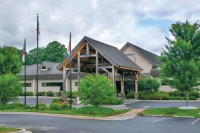The case for ball and bat
Like many of the stakeholders in the argument, county commission chairman Kirk Kirkpatrick wishes the county could build enough fields for both sports. He played baseball in college, and his daughter is currently a soccer player.
But if he has to pick, Kirkpatrick believes the baseball and softball community is next in line for an upgrade, citing the county’s recreation master plan showing a greater deficit of softball fields than soccer fields.
The county’s Allens Creek park — constructed nine years ago — elicited a similar debate between soccer and softball. Ultimately, it was designed as purely a soccer park since the need for soccer fields was greater at the time. It has three playing areas, although none are regulation size required for hosting tournaments.
Baseball/softball advocates argue it is their turn now. The county doesn’t operate any baseball or softball fields. Instead teams rely on private fields, town fields and school fields available for teams.
“The main thing that I see is the lack of county-owned baseball fields, but that’s why I also support a multi-use field out there,” said Kirkpatrick, who is also a member of the recreation board. “It’s just hard to get a full-sized soccer field or a full-sized baseball field in the mountains.”
Kenny Mull, assistant commissioner of Mountaineer Little League, is in the same boat as Kirkpatrick, having also been parent of soccer players. But he says the opportunity of having a county-owned baseball/softball facility has been a long time coming.
“I don’t have anything against soccer, but I’ve been with the Little League for 35 years,” Mull said. “It is our time, I think.”
For nearly the entire existence of Mountaineer Little League’s boy’s baseball and girls’ softball programs, games and tournaments have been hosted on fields owned by private civic organizations like the Elks and the American Legion.
The result has been that Mull and other Little League administrators have had to undertake field maintenance on their own, adding a huge amount of cost and labor to the league’s operations.
“It’s really something we need badly and we’ve never had the opportunity to get,” Mull said. “We’ve never even had the chance to push for it until now.”
What Mull is pushing for is a county-owned and maintained tournament caliber baseball/softball complex for the more than 500 boys and girls ages 8 to 16 in the Mountaineer Little League system.
The plan they favor calls for a “wagon wheel” four-plex field setup that would accommodate the new Little League field specifications. As the game has developed, the regulation distance for fences has been moved from the old distance of 200 feet to 225 feet.
Mull said a “wagon wheel” field setup at Jonathan Creek could allow the Little League to hold regional tournaments with four games going simultaneously. The facility could also be a home for adult softball tournaments, though softball fields require 300-foot fences.
“If you had a field like that, you could host Little League tournaments and traveling tournaments any weekend you wanted to,” Mull said.
Mull explained that the Mountaineer Little League currently hosts tournaments among a variety of locations, making it hard for out-of-town visitors to enjoy the experience because they are rushing from one site to another.
He sees the potential for a centralized tournament complex as a revenue boost for the county.
“It’s a great moneymaker for the county, because it brings people into the hotels and restaurants and everything,” Mull said. “It’d be a really good thing. I hope it works out.”
Lee Starnes, past president of Mountaineer Little League, has attended the planning meetings and looked at the proposals. For Starnes, the proposed baseball/softball complex would provide much-needed practice space and solve a longstanding problem.
“Because of our location in the mountains, we simply don’t have the available space and what is available is expensive,” Starnes said.
Like Kirkpatrick, Starnes said he wished the county could build both tournament soccer and softball facilities, but he knows the county budget won’t allow it.
“I’m in for all of it,” Starnes said. “It’s for the kids, and whatever we can do for the kids is great.”
The case for soccer
Soccer coach Nathan Trout recalled, with a tinge of jealousy, the four “unbelievable” sports parks in his Florida hometown, including six soccer fields.
“It’s almost embarrassing for the community to not have nice facilities for their kids,” said Trout. “I’m just surprised that there’s not a piece of land where they can build it all.”
Trout said he doesn’t understand why the county can’t accommodate athletes from multiple sports in one convenient location.
Trout, who coaches a traveling girls’ team for Carolina Mountain Soccer Club, says he’s had trouble convincing other teams to come to Haywood County.
“Here, we’re so limited,” said Trout. “Obviously, baseball is facing the same problem.”
Currently, the county has no regulation-size soccer fields, and the facilities that are around are either not well-maintained or not publicly available after hours. None of them are striped for soccer, according to soccer coach Geoff Chitea.
Not infrequently, slack mowing schedules allow grass to grow too high for play, while fields remain wet long after rainfall.
Some field owners bar access after hours due to potential liability issues, and others drag the goals off the field to specifically discourage soccer games after hours.
“They don’t want the grass messed up,” said Chitea, who likened playing soccer without goals to playing basketball without a backboard.
Both Trout and Chitea argue that developing soccer fields at the Jonathan Creek Park would benefit more people than the community realizes.
Trout estimates that 600 kids play soccer in Haywood County alone, while Chitea emphasized that adults like to play casual games all throughout the year. On most evenings and weekends, about 15 to 20 people regularly show up to play pick-up games of soccer.
“We’ve had nights during the summer where our numbers swell up to 30 people,” said Chitea.
While football and baseball enthusiasts pack up whenever their season ends, Chitea says there’s really no such thing as a soccer season.
“You see soccer players out on those fields all year long whenever the weather’s nice,” said Chitea.
Trout and Chitea said they are disappointed with the three options presented by the recreation board at the last meeting.
“Obviously, soccer really took a backstage to baseball/softball,” said Chitea. “They all look like we built a baseball facility, not a community park.”
Chitea says the multipurpose field seems more like an afterthought, with restrooms situated much closer to the baseball fields in all three options. Kids who play anything other than baseball or softball will face a much longer trek to the bathrooms.
Chitea says he does appreciate the walking trails at the park, and hopes that the multipurpose field will at least be Astroturf to allow for soccer play year-round.
Meanwhile, Trout would like to see the Haywood County community readjust its focus. Citizens placed too much stress on the park’s ability to drive revenue at the first public meeting, Trout said.
Rather than chasing athletes from other towns, the county’s primary concern should be taking care of the youth at home.
“I think there’s too much focus on worrying about tournaments and driving revenue, rather than taking care of the kids and the community that presently play here,” said Trout.
A tale of two sports at new Jonathan Creek Park
It’s not often that soccer players go head-to-head with softball and baseball athletes.
But whenever Haywood County decides to build a new recreation park, they may do just that.
A competitive spirit creeps from the field into public meetings, as athletes from the same sport band together to make the case for a facility that will best meet their needs.
In recent years, the debate has fostered a rivalry between soccer lovers and those passionate about baseball and softball. Now that the county has begun design work on a new park in Jonathan Creek, the same dialogue has resurfaced.
Of course, the county recreation board would love to satisfy athletes from all sports with pristine new fields, but lack of available funding demands tough choices.
So far, Haywood’s recreation board has collected ample citizen input to assist them in the decision-making process. The board has put out two online surveys and held two public meetings. An impressive crowd of almost 60 people piled in to have their say at both meetings.
For this round, the baseball/softball folks have earned a clear upper hand, despite soccer players’ success in skewing the online survey results toward developing a soccer field.
The county recreation board has opted for a mix of uses at the Jonathan Creek park with a heavy emphasis on baseball and softball. The three potential design concepts presented at the last public meeting each include four baseball fields and one “multipurpose” field.
Two sets of plans for the park have emerged as frontrunners. One plan entails four softball fields and a large multipurpose artificial turf field that could be adapted as a full-size soccer field. The other also has four softball fields clustered centrally as a single complex, but leaves less space for the multi-use field, which is smaller.
The board’s decision was heavily guided by a recreation master plan developed by the county in 2007. The plan demonstrates a clear need for more facilities for all three sports, but a greater deficit of softball and baseball fields than for soccer.
“The master plan is just clear cut, right there,” said Claire Carleton, Haywood County recreation director. “Since we don’t have any baseball/softball fields, that’s where the most urgent needs lies.”
According to the study, the county needs seven more baseball fields and seven softball fields by 2027. In comparison, there will be a deficit of only two soccer fields and two multipurpose fields that same year.
On the other hand, soccer fields are cheaper to develop than baseball and softball fields. Building a soccer field with a goal on each end is a less complicated proposition than developing baseball and softball fields with dugouts, fencing and score boxes.
On Tuesday, April 6, the recreation board will consider which of the three plans to adopt. Each side continues to make their case, and one thing is clear: the debate is far from over in Haywood County.
Developing a moneymaker
Money is not trailing far behind sports in the minds of citizens enthused by the new park.
Residents overwhelmingly favor developing a sports park that produces revenue by ushering traveling teams to the region’s hotels, restaurants and other businesses.
Investing in a high-quality sports complex does have potential to bring serious cash flow into the county, according to Steve Fritts, landscape architect with Barge, Waggoner, Sumner and Cannon.
His firm, which is designing the Jonathan Creek Park, recently completed a tournament-size softball complex in Chattanooga. On its opening weekend, 250 teams descended on the town to utilize the $11 million, eight-field complex.
Meanwhile, the vision for a park in Jonathan Creek is currently limited to 22 acres of space. Fritts has recommended expanding the park to at least 40 acres in the future.
A dearth of funding is the major obstacle in creating a larger park, however. Haywood County commissioners have already dropped $1 million to purchase the park property, while the Town of Maggie Valley also chipped in $115,000 toward the property purchase.
In addition, the recreation board has found it difficult to commit the entire park to just one sport. It turned down the firm’s proposal for developing five baseball fields — even though that would likely prove more lucrative in attracting tournaments.
Recreation Director Claire Carleton said the board shied away from narrowing the scope of the park to ensure that the community facility offers something for everyone.
The three concepts the board chose included not only baseball/softball fields and a multipurpose field, but also a playground, an accessible fishing pier, a greenway trail, a water play area, a loop trail with fitness stations, and picnic shelters.
While a larger park would improve prospects of hosting tournaments, Carleton is pleased with the progress on the park as is.
“This is an excellent start for the county,” said Carleton.
Despite a meeting scheduled for Tuesday, April 6, the board may not vote on adopting a specific plan just yet. County Commissioner Kirk Kirkpatrick, who sits on the recreation board, pointed out that the reality of a new recreation facility is still a long way away.
“The fact of the matter is this is a plan to utilize that property but not necessarily the exact plan that will be used at the time of construction,” Kirkpatrick said.
Baseball and soccer battle for space at new Haywood rec park
Haywood County residents have another chance to steer plans for a park in Jonathan Creek at a public meeting at 6 p.m. Thursday, March 25.
The meeting will be held at the County Office building on Russ Avenue past K-Mart, formerly known as the MARC building.
The design firm will present up to three conceptual master plans for the park, based on input from the first public meeting held March 4 and an online survey.
The first meeting drew a crowd of about 45 people, with most people supporting baseball/softball fields, a soccer field, or fitness trails at the park.
Residents also favored developing a handicapped fishing facility, batting cages, and a fit course. They hoped to see the park maximize revenue potential and gear recreation to locals.
Meanwhile, soccer fans mobilized support to dominate an online survey posted online from March 5 to 22. About 75 people completed the survey, with 21 respondents advocating for soccer fields and opposing baseball/softball fields.
Claire Carleton, Haywood’s recreation director, said the public meeting was civil even though attendees had clashing interests there as well.
“It’s not a conflict,” said Carleton, “Everyone is going after their passion, whether it be baseball or softball.”
Many who completed the online survey said they liked the idea of mixing different uses, though they did not provide a clear direction for what should be included in that mix.
Haywood County commissioners purchased the 22-acre property for $1 million in 2007. In February, they hired the design firm of Barge, Waggoner, Sumner and Cannon Inc. to develop a master plan.
Each of the workshops will build on the information gathered from the previous meeting. After receiving input at Thursday’s public meeting, the firm will develop a draft master plan and determine costs.
A third and final public workshop will be held on Tuesday, April 27, at Maggie Valley Town Hall.
The firm hopes to present the final master plan to the county board of commissioners on Monday, May 17.
For more information, contact Haywood County Recreation and Parks at 828.452.6789.









